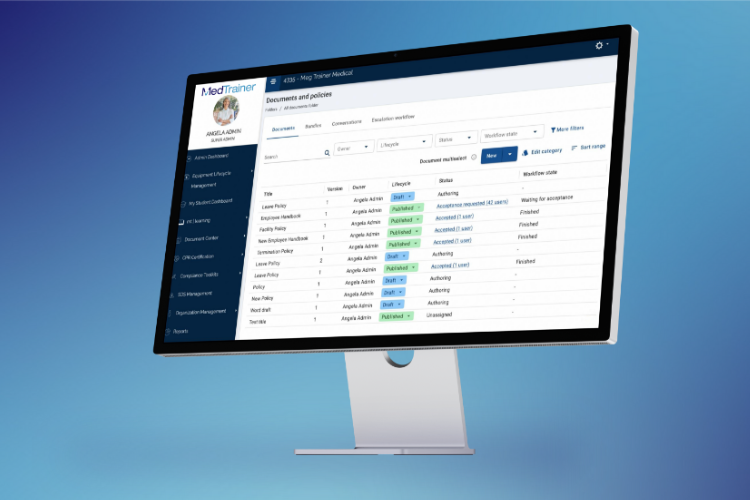Risk is one of those four-letter words that’s almost taboo in the healthcare industry. Everyone is aware of risk, but no one wants to face it. That’s why enterprise risk management (ERM) is so important.
ERM isn’t just about recognizing risk; it’s about reducing it and any potential consequences that might follow it. A comprehensive approach to ERM can transform risk from a sensitive topic into a well-managed aspect of compliant caregiving. It has the power to improve patient and job safety and satisfaction, and enhance efficiency and service quality.
Here’s a closer look at ERM as a concept and what it looks like in practice, as part of a comprehensive approach to healthcare compliance.
What Is Enterprise Risk Management in Healthcare?
Enterprise Risk Management (ERM) refers to a systematic approach to identifying, assessing, mitigating, and managing risks across an organization. In the context of healthcare, ERM encompasses clinical, operational, financial, legal, reputational, and strategic risks. The primary goal is to create a risk-aware culture within the organization, allowing stakeholders to identify and respond to risks effectively.
By bringing risk to the forefront of operations, healthcare organizations can shift perspective. ERM is about a concerted effort to identify and reduce risk; not hide from it or downplay it. And, by examining risk across the scope of operations, ERM sets a precedent for accountability.
What Is the Difference Between ERM and Traditional Risk Management?
ERM and traditional risk management differ in their scope and approach. While both focus on mitigating risks, the primary difference is the scale at which they occur. Here’s a look at some of the features that separate ERM from traditional risk management:
- Scope. Traditional risk management typically focuses on managing risks within specific functional areas or departments of an organization, such as finance, operations, or human resources. In contrast, ERM takes a holistic approach. It considers risks across the entire organization, encompassing all areas and functions. ERM recognizes that risks are interconnected and can have cascading effects throughout the organization.
- Integration. Traditional risk management is often treated as a separate function or department within an organization, operating independently from other functions. ERM, on the other hand, integrates risk management into the organization’s overall strategy, decision-making processes, and governance. It emphasizes the involvement of all stakeholders and promotes a risk-aware culture throughout the organization.
- Proactivity. Traditional risk management tends to be reactive, focusing on identifying and managing risks as they arise; ERM adopts a proactive approach. It emphasizes the identification and anticipation of risks before they materialize, allowing organizations to take preventive measures and develop strategies to mitigate risks and consequences.
- Strategic Alignment. ERM aligns risk management with an organization’s strategic objectives. It considers risks that can hinder these objectives and helps prioritize them based on their potential impact. Traditional risk management, while valuable, may not always have a direct connection to the organization’s broader strategic direction.
- Stakeholder Engagement. ERM recognizes the importance of engaging everyone in the risk management process. It encourages active participation, communication, and collaboration among staff to identify, assess, and manage risks effectively. Traditional risk management may have a narrower focus and typically involves specific officers or management figures.
- Long-Term Perspective. ERM emphasizes the long-term sustainability and resilience of the organization. It takes into account emerging risks, trends, and uncertainties that could impact the organization’s integrity or compliance. Traditional risk management often focuses on immediate risks and may not have a comprehensive view of the organization’s long-term risk landscape.
Tips for Implementing Enterprise Risk Management
Even for facilities that have a firm handle on risk management, the shift to ERM can be intimidating. De-siloing risk assessment, mitigation, and management takes a concerted, cooperative effort. Here are some tips for easing implementation:
1. Online Incident Reporting
Empower a culture of safety, where incident reporting is encouraged and easy to complete. Use an online incident reporting system and make them broadly accessible to everyone. On the back end, make sure you can easily pull data to identify trends — for instance, data that might show if a specific department or location consistently has the same risks reported. This paper trail will also be important during an audit, to show that you’ve addressed risk concerns.
2. Review Policies and Procedures
Look at your policies and procedures through an ERM lens. Standardized processes will reduce risk, so standardize as much as you can. Once they’re updated, make sure you create a training module and upload it to your online compliance platform, so all employees are training on the policies and procedures. A unified compliance platform will also make it easier to track employee acknowledgements that they reviewed the policies.
3. Involve Your Staff
Staff often see things differently and can bring with them diverse perspectives. Has anyone noticed incidents that weren’t reported? Do some of your employees have ideas from other facilities where they’ve worked? Consider having focus groups or surveys to learn from them, and show every employee that their input is valuable. To create a culture of risk management, you need buy-in from everyone. Listening and learning — and showing that input is valued — is the first step in creating that buy-in.
4. Make Learning an Organizational Initiative
Employee training is one of the best ways to implement ERM. A learning management system (LMS) will help! Prioritizing education about risk — how to identify, assess, report, mitigate, and manage it — will give employees the confidence to take action in the face of potential risk. Make sure education is accessible, self-paced, and segmented to instill concepts without overwhelming learners. Tracking education through an LMS is also a great way to monitor compliance — especially in the face of new risk-mitigation initiatives.
Reducing Risk in Your Healthcare Organization
Undertaking an ERM approach is a major endeavor, but one that pays dividends for providers, patients, and healthcare organizations alike. By identifying risk at an enterprise level, organizations empower everyone to do their part in mitigating it. If you don’t already have modern processes in place for education and compliance documentation, seriously consider adding a compliance platform, such as MedTrainer, to make enterprise risk management a little smoother.
Streamline your compliance with MedTrainer

